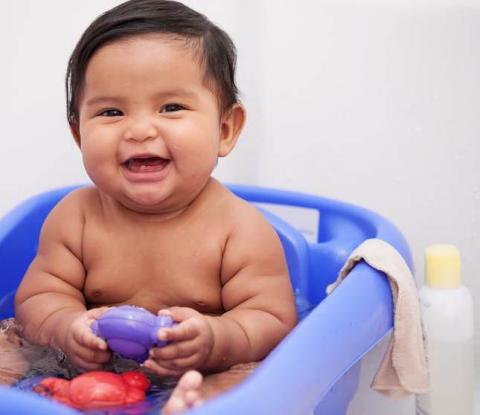Baby cosmetics still contain too many ingredients of concern

Worried about everyday exposure of infants and children to potential chemicals of concern, IPEN Participating Organization WECF has released a survey on 341 baby cosmetics – cleansing milks, lotions, shampoos, bath products, ointments, baby wipes, cleansing waters, eaux de toilettes, sun protection products – sold on the French market in pharmacies, parapharmacies, supermarkets and organic shops. WECF’s experts assessed the products’ ingredients based on the labels. Based on an analysis of existing scientific literature and opinions by European Union (Scientific Committee for Consumer Safety - SCCS) and French (National Agency for the Safety of Medical and cosmetic products - ANSM) risk assessment agencies, the experts classified the ingredients or families of ingredients used in the 341 products in three categories from “high risk” to “moderate risk” and “low or not identified risk”.
Survey’s outcome :
The 3 ingredients or families of ingredients classified as “high risk” can be found in 299 products :
- a contact allergen (methylisothiazolinone) is found in 19 products including 7 wipes
- a preservative suspected to be reprotoxic (phenoxyethanol) is used in 54 products including 26 wipes
- perfume or fragrance are used in 226 products, which may imply potential risks of allergies.
The 4 ingredients or families of ingredients classified as “moderate risk” can be found in 181 products :
- a common ingredient of foaming products (EDTA) is found in 87 products, including 30 wipes
- sulfate compounds (laureth and lauryl sulfate), foaming agents which can be irritants are found in 50 products, a vast majority in bath products and shampoos
- mineral oils, byproducts of petroleum, which may be contaminated by impurities, are found in 30 products, mainly lotions, oils and creams
- nanoparticles, whose effects are still not sufficiently assessed, are used in 14 sun protection products.
Based on these elements, WECF :
- asks for the ban of the the 3 ingredients classified as “high risk” in all cosmetics for children under 3
- questions the use of the omnipresence of unnecessary perfume/fragrance (226 out of 341) in baby cosmetics, which are potential sensitizers and for some known or suspected contact allergens
- asks for a restriction on use of ingredients classified as “moderate risk”, in accordance with the precautionary principle
- requests a moratorium on suspected endocrine disruptors (EDCs) in baby cosmetics for the time being, as long as the European Commission does not release EDCs criteria, which it plans for summer 2016
- recommends caution with ingredients of the third category, whose risks are not clearly identified, very often due to the absence of scientific data.
In addition, to allow for a better understanding of infants’ and children’s real exposure, WECF requests that the assessment of the safety of cosmetics shall be made based on the product formula sold to the consumer and not only based on individual ingredients assessment. WECF requests as well to label contact allergens as to make them easily identifiable by consumers, especially for potential contact allergens. WECF advises parents to limit the use of cosmetics and avoid as much as possible scented products.
Information on the complete survey are available on line (in French) disponibles en ligne
WECF Contact :
Elisabeth Ruffinengo, Advocacy officer elisabeth.ruffinengo@wecf.eu, + 33 (0)6 74 77 77 00
WECF (Women in Europe for a Common Future) is an international network of 150 women and environmental organizations acting together with women to build a world which is fair, healthy and sustainable. WECF elaborates and implements training and awareness raising programmes on the potential health effects of environmental contaminants on human health, especially the most vulnerable populations. WECF has created the Nesting project www.projectnesting.org. WECF carries out policy and advocacy activities and is official partner of UNEP (United Nations Environment Programme).
